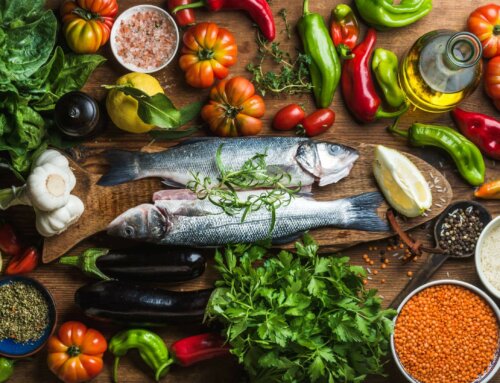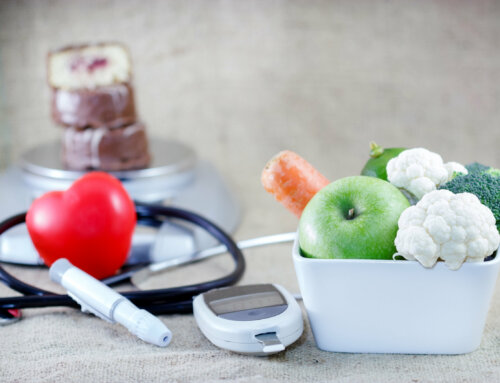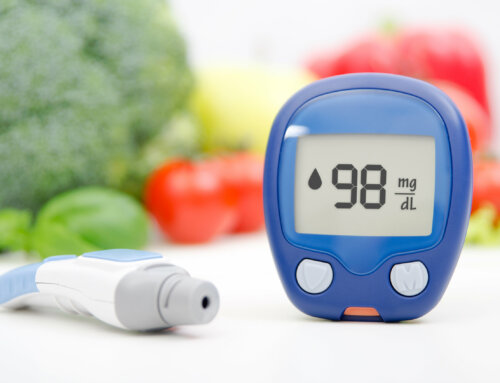Each educational session in our diabetes self management accredited program begins with a health history and assessment. This is followed by a complete lesson on the basics of diabetes: risk factors, complications if not controlled, medication information (how and when to take), assessing insulin technique skills as well as focusing on exercise and overall healthy lifestyle changes.
As the RN/CDE (registered nurse / certified diabetes educator), I am in charge of these aspects of the course. There are frequent sessions when a patient interrupts and states that all they are interested in is “what to eat?” Luckily our RD/CDE (registered dietitian / certified diabetes educator, the professional who teaches about nutrition) is also good at making them understand that diabetes “is more than what you eat” – although it does play a tremendous part in your future diabetes control. We try as a team to offer easy but worthwhile nutritional tips which can be accomplished without tremendous change, headaches or expense. Topics addressing food often increases interest from our customers, so I wanted to review some easy and tried tips. Enjoy!
- You do not have to be bored, tortured, starved, eat bland foods, break the budget or be deprived of tasty easily prepared foods when you have diabetes. You should stay away from trans-fats completely, moderate saturated fats and target healthy monounsaturated fats such as nuts, olive or canola oil. Remember all fats, even healthy ones, have more calories per serving than proteins and carbohydrates – so watch your portion sizes.
- You should learn to shop the perimeter of the store and focus on fresh fruits and vegetables (especially during the spring and summer months), eat lean proteins, whole grains in the bakery and add low fat diary. Skip the box/bag middle section of the store for improved health. Buy products on sale when possible, 2 for 1 and use coupons for savings. I often teach patients who are on food stamps with a limited budget. Buy a roasted chicken which can last for 4 dinners instead of eating processed meat and cheese which is considered a cheap option. Eggs or a peanut butter sandwich would also be a better choice than processed meat and cheese.
- You should include plant proteins as often as possible, including lentils and beans. A recent study published in Diabetes Care has “linked high protein diets – animals in particular – to an increased risk of type 2 diabetes, especially in women.” There were over 15,000 participants in 8 European countries over 12 years in this study; other studies have looked at animal protein intake before, but not with such a large population. They compared meat, dairy and fish proteins. “The diabetes risk was 10% higher in women and 19% higher in obese women. There was no confirmed correlation with men in the study. There was no associated risk with dairy, fish or plant proteins for diabetes type 2. Since men were not at increased risk further studies will examine hormone differences.” There are many other proven risk factors for type 2 diabetes – including family history, ethnicity, age, weight, body shape, as well as activity level. It is presently a suggestion to limit red meat similar to the Mediterranean diet. The Mediterranean diet is extremely popular now in many health circles. It focuses on fish, nuts, olive oil, and small amounts of red wine, plant proteins and whole grains.
- Skip high fat appetizers like nachos, coconut fried shrimp or fried potato skins. Watch out for the endless bread and butter baskets offered at restaurant chains. Instead, start with a leafy green salad dressed in oil and vinegar and add one slice of bread and a full glass of water. Skip the house flavored ice tea which often has added sugars and artificial flavors and stick to water or club soda with a slice of lemon or lime. Order hot tea which has many health benefits.
- Watch out for high calorie and fat coffee drinks which usually contain tons of sugar, whipped cream, lots of carbohydrates and artificial flavorings. Opt for a regular coffee with low fat milk. Regular or decaf coffee has appeared in several studies with positive benefits (in moderation) for people with diabetes. Even a latte with fat free or low fat milk with cinnamon is a healthy choice.
- Just skip the buffet and order off the regular menu. Although the buffet may be cheaper and quicker there is so much temptation. Summer travels involve time on the road or to a far away place on a cruise. You are often confronted with the breakfast / dinner / dessert buffet. If you must, make only one trip and be very selective. Use a salad size plate. Look for the fresh foods and non-starchy vegetables; skip the salads heavy in mayonnaise. Check the buffet before you choose. Skip the French toast covered in maple syrup, berries in syrup and butter. Skip the biscuits, sausage and gravy and think about oatmeal and fruit with an egg or cheese instead. Order a veggie omelet and eat with whole grain toast and fruit. Skip the fruit juice and eat a whole fruit instead. Watch out for sauces, casseroles and gravies – all added calories. Stick to foods with simple preparation. Sit far away from the buffet. Remember, a plain bagel counts as 4 servings of a carbohydrate and often you are limited to 2-3 servings per meal. Look for vegetable soups with lean protein. Choose a dessert and take a few bites. When baking, use applesauce in place of sugar or add spices such as vanilla or almond extract, cinnamon, nutmeg to add sweetness. Share foods. Pack leftovers at the start of the meal to avoid eating the entire portion.
- Fruit smoothies seem like a smart choice, but smoothies enter your blood stream much quicker than the whole fruit; this is due to food particle size and it instantly raises blood sugars. There are often added sugars in these drinks and the portions can be huge. You should make fruit drinks at home when you know the exact portion size and amount of fruit. It is counted as part of your total carbohydrate.
- Frozen dinners can be great when time is short, but make reasonable choices. Stay away from those that are high in sodium, fried, or in cream sauces such as chicken pot pies or macaroni drenched in cheese. Look for products that have the “ideal plate” including half a plate of vegetables, a quarter of a plate of a carbohydrate such as rice, noodles or potatoes and a quarter of a plate of a protein such as lean meat, fish or chicken. A plant protein choice, including beans, is fine. Choose frozen meals containing less than 400 calories, 500mg or less of sodium, a minimum of 2-4 grams of fiber and 15 grams of protein. You can add extra servings of plain frozen vegetables for added fiber which will help you feel satiated and hold blood sugars down.
- Watch out for flavored waters. You can’t assume that they are all calorie free. Many are but you must read the label. Remember to look at the serving size. If a flavored water contains 35 calories per serving and the bottle is 2 ½ servings, then you have almost 100 extra calories with hidden sugars. Try to stay away from beverages with calories – unless it is low fat milk, which counts as a carbohydrate.
- Learn that you can splurge every now and then, but make it for a special time. If you celebrate with Chinese fried rice and fried egg rolls one day, French fries another day and deep dish pizza the next you are not helping your general health or diabetes control. Learn moderation on an occasion, and count your special treat as that – special!
Eating can be considered a social event for some or the highlight of the day for others. Mindless eating can occur as a trigger to a stressor. Others eat just because they have to. Try to decide which person you are, and if possible, plan ahead. Use these tips to stay in charge of your eating and your diabetes health!
NOTE: Consult your doctor first to make sure my recommendations fit your special health needs.






NICE ARTICLE THANX FOR YOUR INFORMATION…
Thank you for your contributions 🙂